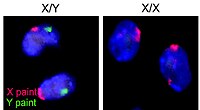
Photo from wikipedia
Across the animal kingdom the duration of copulation varies enormously from a few seconds to several days. Functional explanations for this variation are largely embedded within sperm competition theory in… Click to show full abstract
Across the animal kingdom the duration of copulation varies enormously from a few seconds to several days. Functional explanations for this variation are largely embedded within sperm competition theory in which males modulate the duration of copula in order to optimize their fitness. However, copulation is the union of two protagonists which are likely to have separate and often conflicting reproductive interests, yet few experimental designs specifically assess the effect of male–female interactions on the duration of copulation. This can result in inexact assertions over which sex controls copulatory behaviour. Here we analyse the repeatability of copulatory behaviour in the seed beetle Callosobruchus maculatus to determine which sex exerts primary influence over copulation duration. In C. maculatus, copulation follows two distinct phases: an initial quiescent phase followed by a period of vigorous female kicking behaviour that culminates in the termination of copulation. When males or females copulated with several novel mates, copulatory behaviour was not significantly repeatable. By contrast, when males or females mated repeatedly with the same mate, copula duration was repeatable. These data suggest copulatory behaviour in C. maculatus to be largely the product of male–female interactions rather than the consistent, sex-specific modulation of copula duration of one protagonist in response to the phenotypic variation presented by the other protagonist.
Journal Title: Royal Society Open Science
Year Published: 2017
Link to full text (if available)
Share on Social Media: Sign Up to like & get
recommendations!